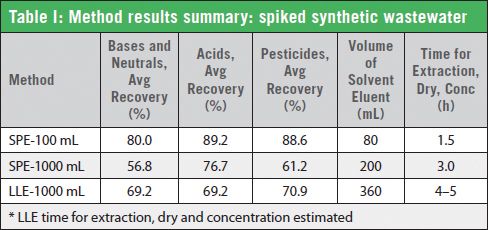New Method US EPA 625 with Solid Phase Extraction for Challenging Wastewaters
Special Issues
This automated SPE methodology is a solution that will reduce analyst labor, solvent usage, and turn-around-time while maintaining the high quality results required within today's laboratories.
US EPA method 625 (1) is used to determine acidic, basic, and neutral semivolatile organic compounds (SVOC) in municipal and industrial wastewater using GC–MS, in many cases for National Pollution Discharge Elimination System (NPDES) compliance. In method 625 revision A, the method is applied to a total possible list of 364 compounds that include; polynuclear aromatic hydrocarbons, chlorinated hydrocarbons, pesticides, phthalate esters, organophosphate esters, nitrosamines, haloethers, aldehydes, ethers, ketones, anilines, pyridines, quinolones, aromatic nitro compounds, and phenols.
In 2013, the Independent Laboratories Institute (ILI), a non-profit workgroup within the American Council of Independent Laboratories (ACIL), met with representatives from the US EPA, vendors, and the laboratory community. Their purpose was to obtain a better understanding of how solid phase extraction (SPE) performs relative to traditional liquid-liquid extraction for a complex matrix such as wastewater.
A mini-round robin study was conducted using an ASTM synthetic wastewater matrix and spike mixtures of undisclosed composition amongst multiple participating laboratories of which Horizon Technology, Inc. and several independent laboratories using Horizon Technology equipment participated. This paper will discuss the results of work done using the SPE-DEX® 4790 Extraction System with synthetic wastewater in a single laboratory to refine methodology used in the subsequent round robin study (2).
To meet the demands of this challenging type of sample, an extraction method requiring only sample acidification to extract over 100 routine compounds has been developed. This method uses disk SPE technology with an extended disk holder using a 47-mm SPE disk while maintaining the use of a 100-mm prefilter, even with dirty samples. The Atlantic® One Pass Disk contains sorbent that is able to extract the large list of semi-volatile compounds without a second extraction at an elevated pH, eliminating the formation of flocculates. A carbon cartridge was used to retain light-end compounds that may pass through the disk.
The results for both 100-mL and 1000-mL samples are shown in Table I for several replicates and show the extraction method is operating well in comparison to method 625 criteria and liquid-liquid extraction. The benefits of a smaller sample volume was a smaller extraction volume of 80 mL of solvent and the processing time to extract, dry and concentrate was reduced to 1.5 h, approximately half the time required for the larger SPE sample and one-third the time required for the LLE sample.

Table I: Method results summary: spiked synthetic wastewater
Conclusions
The data presented illustrates this automated SPE methodology is capable of successfully extracting over 100 compounds specified by the new version of EPA method 625.
- The single pH extraction eliminates the need to basify the sample, reducing the chance of flocculates and resulting low recoveries.
- This new SPE methodology for semi volatiles streamlines the extraction process and allows for all types of aqueous samples to be processed at the same high flow rate.
- This automated SPE methodology is a solution that will reduce analyst labor, solvent usage, and turn-around-time while maintaining the high quality results required within today's laboratories.
The round robin was conducted in two phases with two matrices and new surrogate compounds. The results from the multi-lab study were also very good and the full report was submitted to the EPA Docket in support of allowing SPE use for method 625 Rev A.
References
(1) US EPA Method 625, Revision A, available from US EPA and referenced in Federal Register 80(33), 19 February 2015, p. 8956.
(2) W.R. Jones, A. Cannon, D. Gallagher, M. Ebitson, and Z. Grosser, "New Method US EPA 625 with Solid Phase Extraction for Challenging Wastewaters," AN0911408_01, available from www.horizontechinc.com.

Horizon Technology
16 Northwestern Drive, Salem, NH 03079
tel. (603) 893-3663
Website: www.horizontechinc.com

Separation of Ultra-Short and Long Chain PFAS Compounds Using a Positive Charge Surface Column
December 11th 2024A separation of ultra-short and long chain PFAS (C1-C18) is performed on a HALO®PCS Phenyl-Hexyl column along with a HALO®PFAS Delay column which demonstrates excellent retention for both hydrophilic and hydrophobic analytes.

.png&w=3840&q=75)

.png&w=3840&q=75)



.png&w=3840&q=75)



.png&w=3840&q=75)












